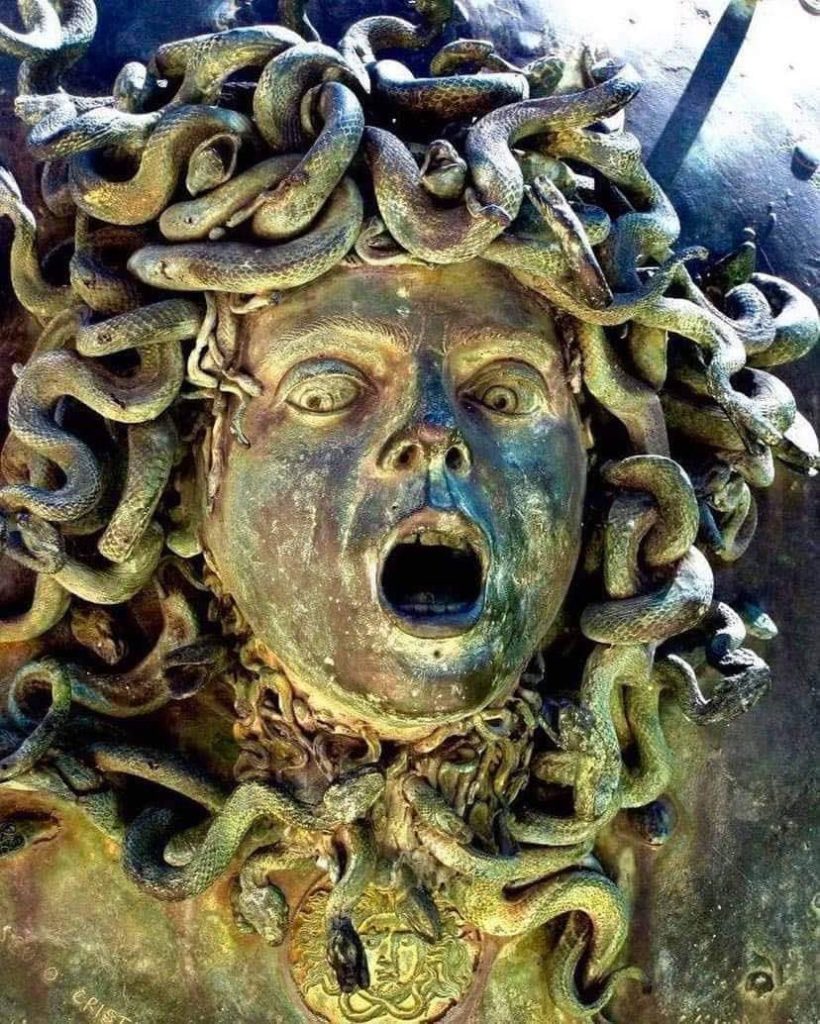In the picturesque hills of Italy, not far from the town of Tivoli, lies one of the most impressive remnants of Roman grandeur—Hadrian’s Villa. This vast archaeological complex, recognized as a UNESCO World Heritage Site, was once the lavish retreat of Emperor Hadrian, who ruled Rome during the second century AD. While the villa itself has long been celebrated for its architectural brilliance and historical importance, a recent discovery has brought renewed attention to the site: the unearthing of a bronze head of Medusa. This artifact, both artistically striking and historically significant, has sparked new interest in the villa’s rich cultural context and the intricate relationship between Roman and Greek traditions.

The bronze head of Medusa, found in one of the villa’s opulent areas, immediately captivates with its lifelike detail. Her piercing gaze and serpentine hair are not merely artistic flourishes; they are imbued with profound symbolic meaning. In Greek mythology, Medusa was one of the three Gorgons, and her gaze could turn people to stone. While the myth itself is rooted in Greek lore, the Romans embraced it, weaving it into their own artistic and cultural expressions. This particular representation of Medusa is not just decorative—it likely served a protective purpose, as the Gorgon’s image was believed to ward off evil and shield against harm. The presence of such a figure in Hadrian’s Villa suggests that even Rome’s elite embraced this belief, blending aesthetics with spiritual significance.
Hadrian’s Villa was more than just a country residence; it was a symbol of imperial power, a place where art, politics, and personal refuge intertwined. Spanning over 250 acres, the villa was a testament to Roman engineering and architectural mastery. It featured palaces, theaters, baths, temples, and expansive gardens. The discovery of the bronze Medusa within this grand setting speaks volumes about the tastes and values of its creator, Emperor Hadrian himself. A known admirer of Greek culture, Hadrian infused his villa with Hellenistic elements, making it not only a retreat from Rome but a space that celebrated the merging of Greek and Roman ideals.
The Medusa head is a perfect example of this cultural fusion. While it embodies a Greek mythological figure, its craftsmanship and placement within the villa are distinctly Roman. It illustrates how the Romans did not merely copy Greek art but reinterpreted it to reflect their own identity and values. Walking through Hadrian’s Villa, one is struck by the harmonious blend of these two great civilizations. Statues, mosaics, and structures speak of a time when the Roman Empire stood at the height of its power, yet looked to Greece for inspiration in art, philosophy, and mythology.
What makes the Medusa artifact particularly fascinating is how it transcends time. Thousands of years after it was crafted, it continues to evoke wonder. Its discovery not only adds a tangible piece to the historical puzzle of Hadrian’s Villa but also reminds us of the enduring nature of myth and symbolism. The bronze head is more than an object; it is a link to the past, offering modern viewers a chance to reflect on how ancient peoples understood the world around them and sought to connect with forces they believed governed their fate.
The allure of myth, especially one as potent as Medusa’s, lies in its ability to convey complex ideas through powerful imagery. To the Romans, Medusa was not simply a monster; she was a guardian, a figure whose terrifying visage could protect homes, temples, and people from unseen dangers. This belief in the protective power of art is deeply human and resonates even today. As visitors stand before the bronze head, they are not only observing an ancient relic—they are participating in a dialogue that spans centuries, contemplating the same questions and marveling at the same mysteries as those who once walked the villa’s halls.
The discovery of this bronze Medusa also underscores the importance of continued exploration and preservation of historical sites. Hadrian’s Villa, with its wealth of artifacts and architectural wonders, continues to be a vital resource for understanding the complexities of ancient Roman life. Each new find adds depth to our knowledge, offering insights into the daily lives, beliefs, and artistic achievements of those who came before us.
In conclusion, the bronze head of Medusa unearthed at Hadrian’s Villa is far more than a piece of ancient art—it is a symbol of cultural synthesis, mythological significance, and artistic mastery. It invites us to explore the ways in which history, art, and belief are intertwined, and how they continue to shape our understanding of the human experience. As Hadrian’s Villa yields more of its secrets, the conversation between the ancient and modern worlds continues, reminding us that history is not a static collection of facts, but a living narrative that enriches our present and guides our future. Through artifacts like the Medusa head, we are drawn into the enduring legacy of Rome and the timeless power of myth, artistry, and cultural exchange.





